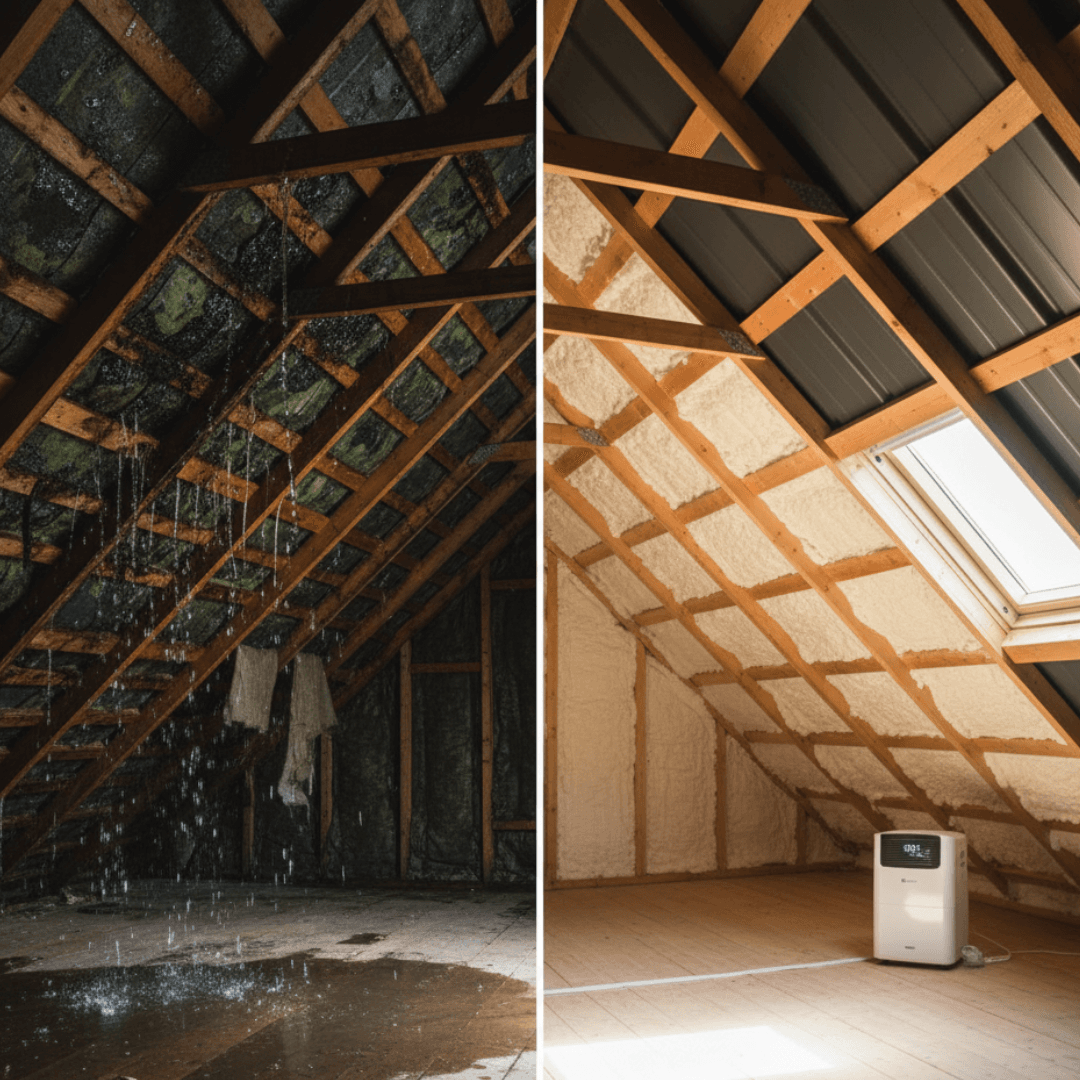New Roof Replacement Prevents Mold and Moisture in Winter

As the cooler months approach in Florida, many homeowners may notice a rise in humidity related issues inside their homes. Older roofs, especially those that have endured years of tropical storms and heat, are prone to leaks, condensation, and insufficient ventilation. These problems can lead to mold growth, structural damage, and increased energy bills. Investing in a new roof replacement is one of the most effective ways to prevent moisture accumulation and protect your home during the winter season.
Why Older Roofs Are Vulnerable in Cooler Months
Older roofs often have worn shingles, deteriorated underlayment, or small cracks that may not be noticeable during warmer months. When temperatures drop and humidity rises, these vulnerabilities allow moisture to seep into the attic and ceiling spaces. Even minor leaks can lead to mold growth, which not only damages property but also poses health risks to your family.
In Florida, winter humidity can reach 60-70%, creating a perfect environment for mold and mildew. Homes with insufficient insulation or aging roofing systems are particularly susceptible.
Key Issues with Aging Roofs:
Shingle and tile deterioration
Broken or missing flashing
Poor attic ventilation
Water pooling or trapped condensation
A new roof replacement addresses these issues by providing modern materials and proper installation techniques designed to withstand Florida’s seasonal weather patterns.
The Role of Proper Ventilation and Insulation
One of the main causes of moisture problems is poor ventilation. When warm, humid air gets trapped in the attic, it condenses on cooler surfaces like the underside of the roof deck. This condensation can accumulate, leading to water damage and fostering mold growth.
Modern metal roofs and other high quality roofing materials include integrated ventilation systems and underlayments that help regulate temperature and moisture levels. Adequate ventilation, combined with proper insulation, ensures that your roof can breathe, preventing condensation even during cooler, humid months.
Benefits of Proper Ventilation:
Reduces mold and mildew formation
Extends the lifespan of shingles and roof materials
Improves indoor air quality
Enhances overall energy efficiency
Installing a new roof with these features ensures your home remains dry and comfortable throughout the year.
Mold Growth: Hidden Dangers of Moisture
Mold growth is not only unsightly but can also pose serious health risks. Prolonged exposure to mold spores can trigger allergies, respiratory issues, and other health problems. Moisture trapped under an old or damaged roof creates the perfect environment for mold to thrive.
By investing in a new roof replacement, homeowners can prevent water intrusion and reduce the risk of mold development. Modern roofing systems include:
Waterproof underlayments
Durable flashing around vents and chimneys
Sealed joints and gutters for proper water runoff
These improvements prevent water from seeping into ceilings, walls, and insulation, keeping both the structure and occupants safe.
Energy Efficiency Benefits During Cooler Months
A roof that leaks or allows moisture infiltration can significantly affect energy bills. Warm air escapes through gaps or damp insulation, forcing your HVAC system to work harder to maintain indoor temperatures.
Replacing your old roof with energy efficient materials can help stabilize indoor temperatures. A properly installed roof acts as a thermal barrier, retaining heat during cooler months and reducing energy consumption.
Energy Benefits of New Roofs:
Lower heating costs by 10-20%
Enhanced insulation prevents heat loss
Properly sealed materials improve HVAC efficiency
Reduces risk of structural damage that can lead to expensive repairs
These savings quickly add up, making a new roof replacement a smart investment for both comfort and financial efficiency.
Choosing the Right Roofing Material
Not all roofing materials are created equal, especially when considering moisture prevention in Florida’s climate. Options like metal roofs offer exceptional durability, resistance to leaks, and long term protection. Metal roofing reflects heat, resists mold growth, and can last 40-70 years with minimal maintenance.
Other materials, such as asphalt shingles or tile, can also be effective if installed correctly and paired with high-quality underlayment and proper ventilation. When selecting a roof replacement, it’s essential to consult a reputable metal roof company or roofing contractor experienced in Florida’s weather conditions.
Signs It’s Time for a Roof Replacement
Homeowners should look for several signs indicating that a roof replacement may be necessary:
Curling, cracked, or missing shingles
Water stains on ceilings or walls
Musty odors indicating mold presence
Sagging or uneven roof surfaces
Frequent need for patch repairs
Ignoring these signs can lead to more significant problems during the cooler months, including structural damage and costly mold remediation.
The Installation Process Matters
Even the best materials won’t prevent mold and moisture if the installation is subpar. Professional roofing contractors ensure:
Proper underlayment is installed for waterproofing
Flashing and vents are sealed and aligned
Roof slope allows for effective drainage
Compliance with local building codes and hurricane standards
A professional new roof replacement ensures long term protection and peace of mind during Florida’s humid winter months.
Older roofs are prone to leaks, mold, and moisture problems, especially during Florida’s cooler months. A new roof replacement addresses these vulnerabilities by providing improved materials, proper ventilation, and professional installation. Beyond preventing mold and moisture, a new roof enhances energy efficiency, protects your home’s structure, and contributes to long-term savings. Investing in a replacement roof is a proactive step that ensures your home remains safe, dry, and comfortable throughout the winter season.
Frequently Asked Questions (FAQs)
How does a new roof prevent mold in cooler months?
A new roof includes waterproof underlayments, sealed joints, and proper ventilation, preventing moisture accumulation that fosters mold growth.
What types of roofs are best for Florida winters?
Metal roofs and quality asphalt shingles with adequate underlayment are ideal, as they resist leaks and mold while providing long-term durability.
How much does a new roof replacement cost in Florida?
Costs vary by material and home size. Average metal roof cost per square foot ranges from $8-$12, depending on installation and location.
Can a roof replacement reduce energy bills?
Yes. A properly insulated and ventilated roof retains heat during cooler months, improving HVAC efficiency and lowering heating costs.
How do I know if my roof needs replacement?
Look for curling or missing shingles, water stains, musty odors, sagging areas, or frequent repair needs. These are signs your roof may no longer be protecting your home effectively.
